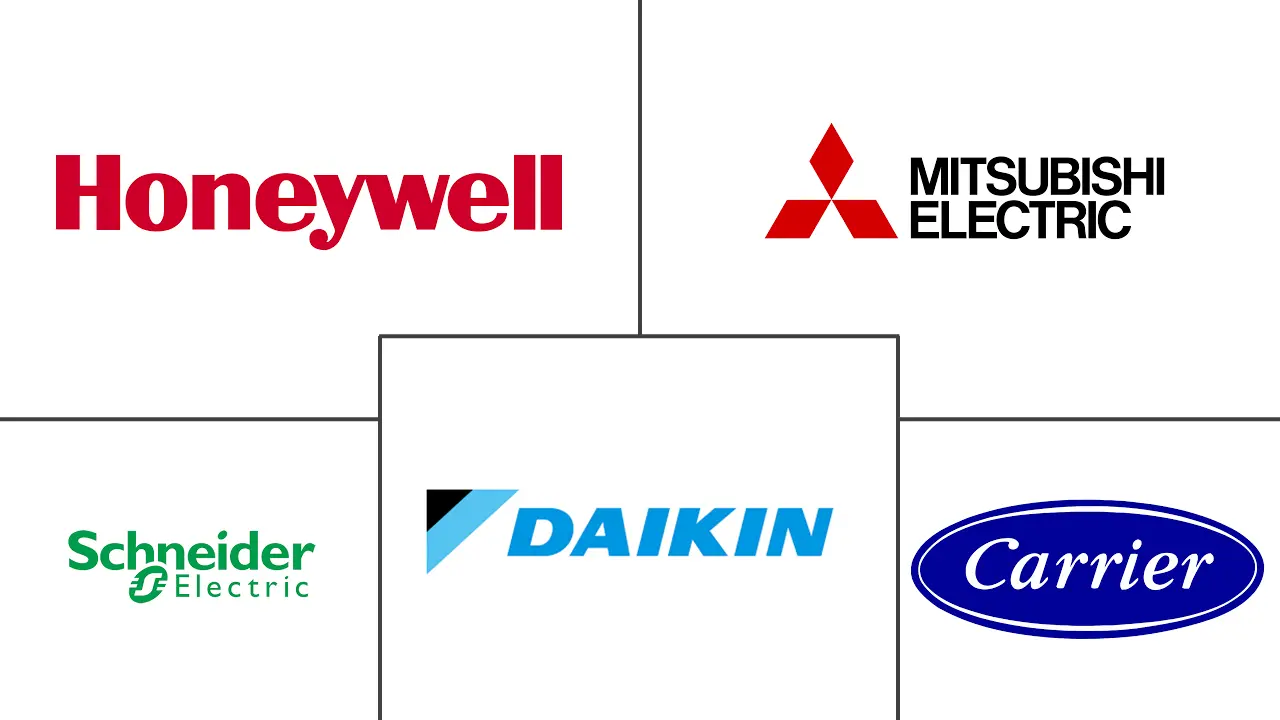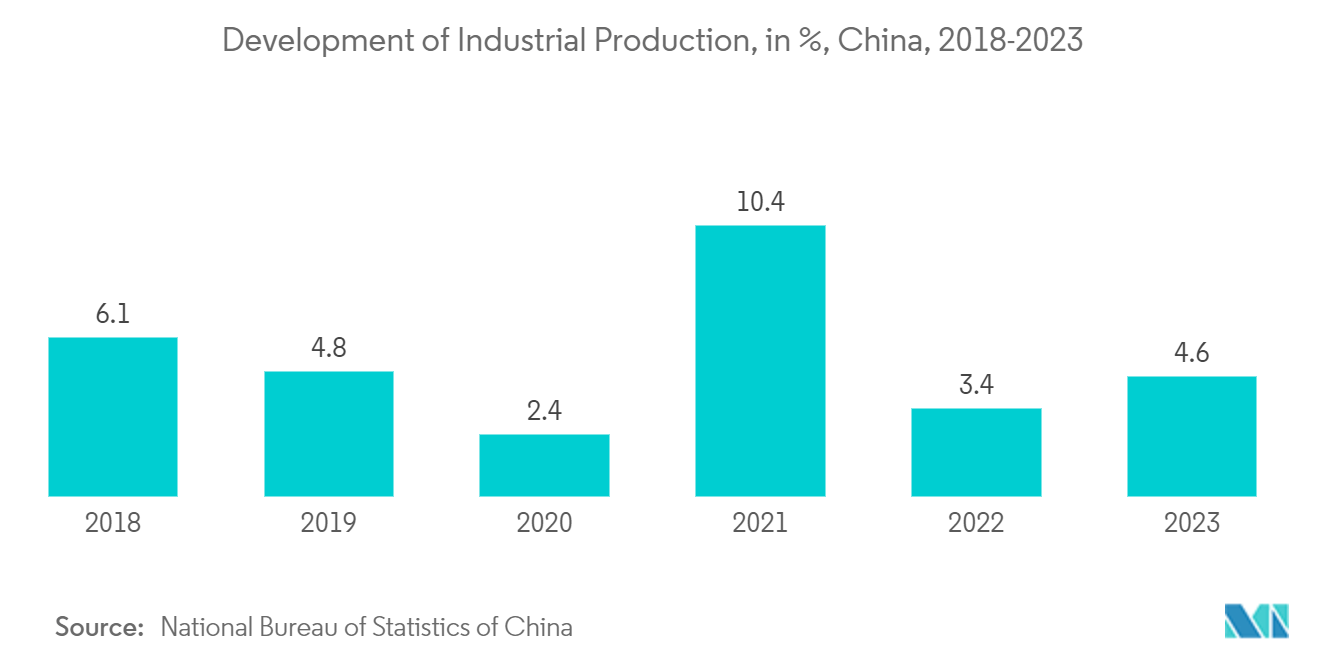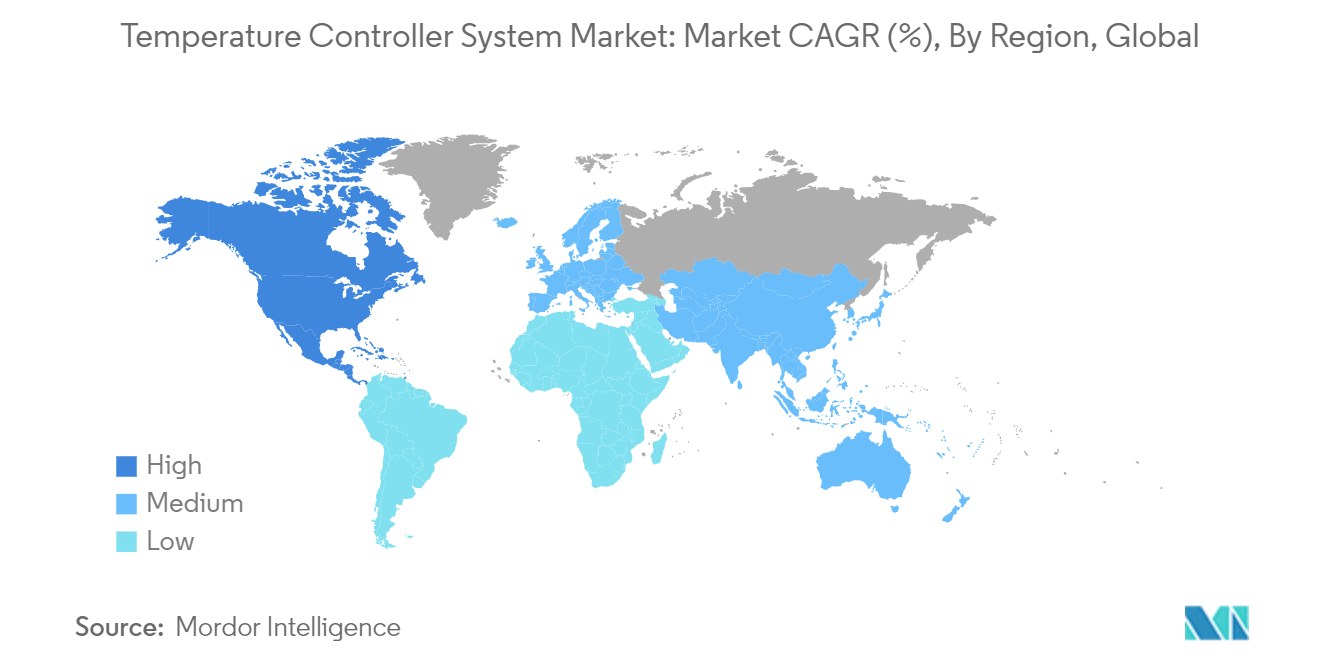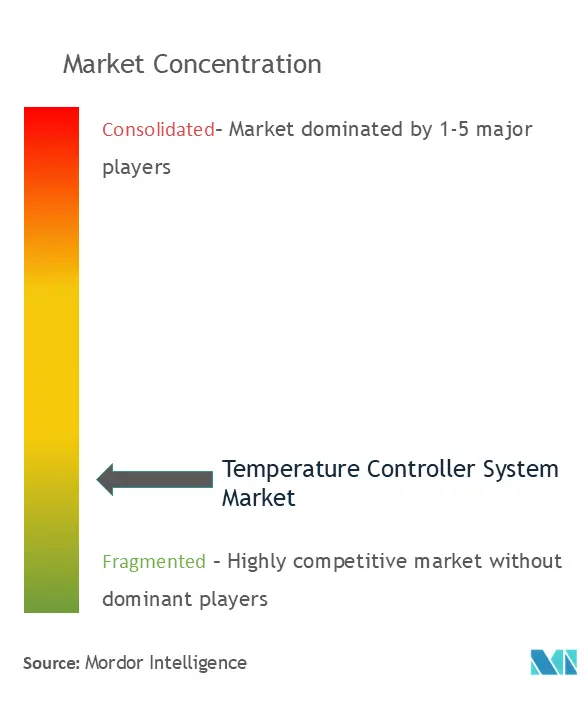Temperature Controller System Market Size

| Study Period | 2019 - 2029 |
| Market Size (2024) | USD 2.11 Billion |
| Market Size (2029) | USD 2.47 Billion |
| CAGR (2024 - 2029) | 3.20 % |
| Fastest Growing Market | North America |
| Largest Market | Asia Pacific |
| Market Concentration | Low |
Major Players
*Disclaimer: Major Players sorted in no particular order |
Temperature Controller System Market Analysis
The Temperature Controller System Market size is estimated at USD 2.11 billion in 2024, and is expected to reach USD 2.47 billion by 2029, at a CAGR of 3.20% during the forecast period (2024-2029).
- Temperature controller systems function by observing the temperature of a system and contrasting it with a predetermined temperature setpoint. When the temperature deviates from the set point, either exceeding or falling short, the controller transmits a signal to modify the heating or cooling system, restoring the temperature to the desired level. The controller persistently fine-tunes the heating or cooling output to keep the temperature within a narrow range around the setpoint.
- The temperature controller system market will witness high growth due to the increasing adoption of HVAC systems in residential and commercial spaces. Temperature controllers play a crucial role in HVAC systems by managing the temperature within a building. They are designed to oversee heating and cooling mechanisms, ensuring a comfortable environment for occupants while optimizing energy consumption.
- According to U.S.the Census Bureau, in 2023, Idaho and North Carolina emerged as the U.S. states with the highest levels of new residential construction, each authorizing more than nine units for every 1,000 residents. In contrast, the national average for that year was 4.51 homes authorized per 1,000 residents.
- Furthermore, one of the key elements contributing to the expansion of the temperature controller system market is the heightened adoption of government regulations to enhance laboratory safety in the industrial sector. These devices fully automate the process, significantly reducing the likelihood of human error that can occur with manual temperature management. Furthermore, in the areas of food preservation and plastic manufacturing, temperature control systems are especially advantageous because of their cost-effectiveness, ease of use, energy efficiency, and capacity to minimize unnecessary energy expenditure.
- Moreover, the rising chemical industry in the emerging nation, will also propel the market growth. In the chemical sector, inadequate temperature control can trigger a series of catastrophic events, including fires, explosions, and the release of hazardous gases. Such incidents pose significant risks to the health and safety of workers and the local community. Additionally, the reputation of the company can suffer as a result of these occurrences. To prevent such incidents, it is crucial for all industries to maintain continuous monitoring and regulation of the temperature within their facilities.
- The operational costs associated with temperature-controlled systems can be considerable, in addition to the initial investment. The requirement for consistent energy input to uphold accurate temperature settings contributes to elevated utility expenses. Furthermore, the energy demands of these systems not only pose environmental concerns but also escalate the overall operational costs for businesses, thus hampering the market growth.
- Furthermore, the global temperature controller system market could be swayed by macroeconomic factors like exchange rate fluctuations and changes in international trade dynamics. Changes in currency values can impact the costs of both imported temperature controller system and their raw materials. This, in turn, can influence pricing strategies and profit margins for manufacturers and distributors. Additionally, trade policies, tariffs, and international agreements can affect the availability and pricing of temperature controller system, especially in countries that heavily depend on imports or exports.
Temperature Controller System Market Trends
Industrial Segment is Expected to Hold Significant Market Share in the Market
- In the realms of manufacturing and packaging processes, effective temperature regulation is essential for maintaining product quality, enhancing operational efficiency, managing thermal stress, and ensuring consistency and reproducibility. Irregularities in machine assembly can result in expensive downtime and considerable time invested in diagnosing and resolving problems. The industrial temperature-controller systems are designed to mitigate these irregularities and substantially decrease the labour hours required for troubleshooting.
- For the industrial sector, temperature controllers are designed to regulate the temperature during heating or cooling operations, independent of the surrounding environmental conditions. These devices monitor the temperature of the medium consistently and make necessary adjustments to achieve the ideal temperature. When the medium attains the specified threshold, these controllers deactivate and will reactivate if there is a subsequent increase or decrease in temperature.
- Across multiple industries, temperature control is crucial for upholding product quality and minimising defects and their associated costs. Deviations in temperature, whether too high or too low, can alter a product's chemical composition, impacting its texture and appearance. To maintain production within the desired temperature range, regular monitoring and timely adjustments are imperative, thus driving the demand for temperature controller systems in the industrial sector.
- Moreover, in a factory, it's crucial to regulate temperatures at different levels: the ambient temperature of the premises, the temperature during the manufacturing process, and the temperature of the equipment. Without an automatic temperature controller, these temperatures are managed manually. This manual oversight leads to inconsistent energy consumption, directly affecting the company's energy expenses. Temperature controllers manage fans, pumps, and control valves through variable speed drives, adjusting operations as needed to prevent excessive energy use.
- Furthermore, the expanding industrial sector across the globe is poised to be a key driver for the growth of the studied market. As several nations embrace advanced solutions like automation, robotics, AI, and IIOT, the demand for temperature controller systems is surging. For instance, the National Bureau of Statistics of China reported a 4.6% rise in China's industrial production in 2023 compared to the prior year.

North America is Expected to be the Fastest Growing Segment in the Market
- The country is witnessing significant growth in its industrial sector, driven by a strong economy, heightened oil and gas production, and favourable manufacturing indicators. Consequently, the demand for temperature controller system in the region is anticipated to rise. Key sectors such as food & beverage, automotive, electronics and semiconductors, and others are identified as the main contributors to this demand.
- As reported by the U.S. Department of Commerce in 2023, the manufacturing sector accounted for USD 2.8 trillion of the United States' gross domestic product (GDP), with the chemical products industry-leading at USD 513.2 billion.
- Furthermore, the food and beverage sector ranks among the largest industries in the United States. The country's diverse demographic and receptiveness to innovative products position the United States as a highly dynamic market for food and beverage brands.
- Temperature controllers play a crucial role in refrigeration systems by regulating the temperature of refrigerated or frozen products. They are essential in preventing temperature variations that could potentially harm the goods or diminish their quality. They are also employed in ovens to manage the temperature throughout the cooking or baking process. They help guarantee that food is cooked or baked uniformly, thereby avoiding issues of overcooking or burning.
- Thus, expansion of food & beverage manufacturing in the region will drive the market growth. For instance, in June 2024, Richmond Beverage Solutions LLC is expanding its presence in Wayne County. As a subsidiary of Dairy Farmers of America, the company intends to invest approximately USD 45 million to enhance its existing facility. This expansion will include the installation of new equipment aimed at modernizing the manufacturing processes at the site. The Richmond plant is responsible for producing a diverse range of extended shelf-life dairy and non-dairy beverages, as well as shake mixes, catering to both retail and food service clients.
- Furthermore, apart from industrial sector, numerous elements are contributing to the expansion of the studied market in the region. These include an increase in the formation of new households, rising average construction costs, rapid urbanization, and a growth in disposable income in different areas. For instance, information from the World Bank indicates a steady increase in the urban population within the United States. In 2023, around 83.30% of the population lived in urban areas, compared to 81.48% in 2014.

Temperature Controller System Industry Overview
The temperature controller market is highly fragmented, with global conglomerates and specialized players operating across various segments. While several large multinational companies dominate certain high-value segments, numerous regional and niche players contribute to the overall competition, making the market highly diverse. This fragmentation is driven by the wide range of applications for temperature controller system, allowing both large and small companies to coexist and thrive in the market.
Leading companies in the temperature controller system market include Honeywell International Inc., Mitsubishi Electric Corporation, Schneider Electric, Carrier Global Corporation, and Daikin Industries, Ltd. These companies have established strong brand recognition and extensive global operations, enabling them to command significant market share. Their strengths lie in innovation, broad product portfolios, and strong distribution networks. These leaders often engage in strategic acquisitions and partnerships to maintain their competitive edge and expand their market reach.
To succeed in the temperature controller system market, companies must prioritize innovation as temperature controller system plays a crucial role in delivering essential commodities across various sectors, including pharmaceuticals, biotechnology, and the food and beverage industry, due to their indispensable nature. Companies that invest in emerging markets and adapt their products to regional needs are likely to gain a competitive advantage in this fragmented market.
Temperature Controller System Market Leaders
-
Honeywell International Inc.
-
Mitsubishi Electric Corporation
-
Daikin Industries, Ltd.
-
Carrier Global Corporation
-
Schneider Electric
*Disclaimer: Major Players sorted in no particular order

Temperature Controller System Market News
- March 2024: OMRON unveiled the new NX-HTC temperature controller. This controller, measuring 30mm in width, is engineered to deliver optimal and automatic control, eliminating the necessity for human oversight. It is particularly suited for applications including the sealing of environmentally friendly packaging materials and the production of advanced semiconductor chips.
- January 2024: Lamonde Automation Limited announced the launch of its SOLO modular temperature controllers. These controllers are designed with a modular snap-together structure, enabling users to incorporate additional units as required. Each controller can be customized with various control modes and output types, allowing for a system that meets the specific needs of the application. The modular temperature controllers provide the same capabilities as the standard SOLO controllers but at a more economical price point.
Temperature Controller System Market Report - Table of Contents
1. INTRODUCTION
1.1 Study Assumptions and Market Definition
1.2 Scope of the Study
2. RESEARCH METHODOLOGY
3. EXECUTIVE SUMMARY
4. MARKET INSIGHTS
4.1 Market Overview
4.2 Industry Attractiveness - Porter's Five Forces Analysis
4.2.1 Bargaining Power of Suppliers
4.2.2 Bargaining Power of Consumers
4.2.3 Threat of New Entrants
4.2.4 Threat of Substitute Products
4.2.5 Intensity of Competitive Rivalry
4.3 Industry Value Chain Analysis
4.4 Impact of COVID-19 Aftereffects and Other Macroeconomic Factors on the Market
5. MARKET DYNAMICS
5.1 Market Drivers
5.1.1 Increasing Adoption of HVAC Will Drive the Market Growth
5.1.2 Continuous Technology Improvements Such As Smart Sensor and IoT Will Drive the Market Growth
5.2 Market Challenges
5.2.1 High Maintenance Costs
6. MARKET SEGMENTATION
6.1 By Type
6.1.1 On/Off Controllers
6.1.2 Proportional Controllers
6.1.3 PID Controllers
6.2 By End-User
6.2.1 Industrial
6.2.2 Residential
6.2.3 Commercial
6.3 By Geography***
6.3.1 North America
6.3.2 Europe
6.3.3 Asia
6.3.4 Australia and New Zealand
6.3.5 Latin America
6.3.6 Middle East and Africa
7. COMPETITIVE LANDSCAPE
7.1 Company Profiles
7.1.1 Honeywell International Inc.
7.1.2 Parker Hannifin Group
7.1.3 AMETEK, Inc.
7.1.4 Schneider Electric
7.1.5 Boyd Corporation
7.1.6 LG Electronics Inc.
7.1.7 Mitsubishi Electric Corporation
7.1.8 Ingersoll Rand
7.1.9 Delta Controls Inc.
7.1.10 Carrier Global Corporation
7.1.11 Daikin Industries, Ltd.
- *List Not Exhaustive
8. INVESTMENT ANALYSIS
9. FUTURE OUTLOOK OF THE MARKET
Temperature Controller System Industry Segmentation
A Temperature Controller system is designed to regulate a heater or similar equipment by assessing a sensor signal against a predetermined set point and executing calculations based on the difference between these values.
The study tracks the revenue accrued through the sale of temperature controller systems by various players in the global market. The study also tracks the key market parameters, underlying growth influencers, and major vendors operating in the industry, which supports the market estimations and growth rates over the forecast period. The study further analyses the overall impact of COVID-19 aftereffects and other macroeconomic factors on the market. The report’s scope encompasses market sizing and forecasts for the various market segments.
Temperature controller system market is segmented by type (on/off controllers, proportional controllers, and PID controllers), by end-user (industrial, residential, and commercial), and by geography (North America, Europe, Asia Pacific, and Rest of the World). The market sizes and forecasts are provided in terms of value (USD) for all the above segments.
| By Type | |
| On/Off Controllers | |
| Proportional Controllers | |
| PID Controllers |
| By End-User | |
| Industrial | |
| Residential | |
| Commercial |
| By Geography*** | |
| North America | |
| Europe | |
| Asia | |
| Australia and New Zealand | |
| Latin America | |
| Middle East and Africa |
Temperature Controller System Market Research FAQs
How big is the Temperature Controller System Market?
The Temperature Controller System Market size is expected to reach USD 2.11 billion in 2024 and grow at a CAGR of 3.20% to reach USD 2.47 billion by 2029.
What is the current Temperature Controller System Market size?
In 2024, the Temperature Controller System Market size is expected to reach USD 2.11 billion.
Who are the key players in Temperature Controller System Market?
Honeywell International Inc., Mitsubishi Electric Corporation, Daikin Industries, Ltd., Carrier Global Corporation and Schneider Electric are the major companies operating in the Temperature Controller System Market.
Which is the fastest growing region in Temperature Controller System Market?
North America is estimated to grow at the highest CAGR over the forecast period (2024-2029).
Which region has the biggest share in Temperature Controller System Market?
In 2024, the Asia Pacific accounts for the largest market share in Temperature Controller System Market.
What years does this Temperature Controller System Market cover, and what was the market size in 2023?
In 2023, the Temperature Controller System Market size was estimated at USD 2.04 billion. The report covers the Temperature Controller System Market historical market size for years: 2019, 2020, 2021, 2022 and 2023. The report also forecasts the Temperature Controller System Market size for years: 2024, 2025, 2026, 2027, 2028 and 2029.
Temperature Controller System Industry Report
Statistics for the 2024 Temperature Controller System market share, size and revenue growth rate, created by Mordor Intelligence™ Industry Reports. Temperature Controller System analysis includes a market forecast outlook for 2024 to 2029 and historical overview. Get a sample of this industry analysis as a free report PDF download.



